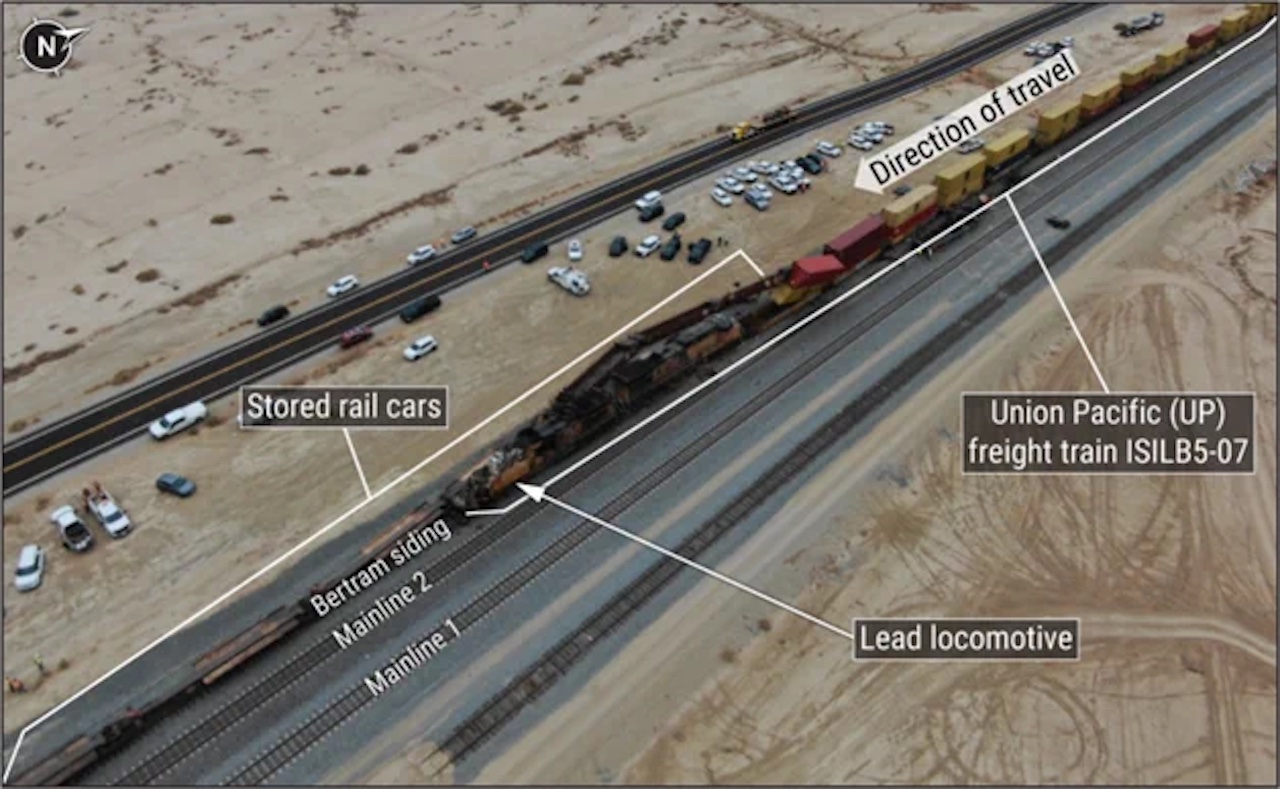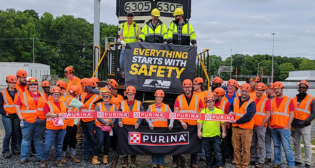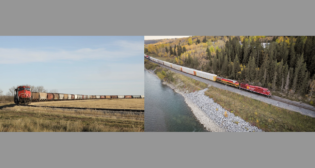
NTSB Opens Public Docket for Ongoing Investigation of Fatal UP Collision (Updated with Commentary)
Written by Carolina Worrell, Senior Editor
The National Transportation Safety Board (NTSB) has opened a public docket for its ongoing investigation of the Sept. 8, 2022 accident near Imperial County, Calif., involving a Union Pacific (UP) freight train colliding with railcars stored in a siding, killing the conductor and engineer.
On Sept. 8, 2022, about 2:40 a.m. local time, the conductor and engineer of UP train ISILB5-07 were killed when their train collided with railcars stored in a siding. The train was traveling eastbound about 28 mph on Mainline 2 when a UP dispatcher routed it into the west end of signal-controlled Bertram Siding at milepost 646.1 on the Yuma Subdivision. The train collided with 74 standing sets of empty intermodal cars (totaling 92 individual wells or platforms) that had been stored at milepost 646.3 since December 2021. The collision resulted in the derailment of the two lead locomotives (UP6018 and UP5599), one intermodal railcar of the striking train, and six of the stored intermodal railcars in the siding.
At the time of the accident, conditions were dark, and the weather was clear, 86°F, with no precipitation. Damage to track and equipment was estimated by UP to be about $1.2 million. UP train ISILB5-07 consisted of two lead locomotives, 122 loaded intermodal railcars, and two locomotives on the rear end.
Post-accident track and switch inspections, NTSB says, revealed no track conditions or defects that met concern, based on UP and Federal Railroad Administration (FRA) track safety standards.
According to the docket, FRA regulations found in 49 CFR part 213 requires that a rail carrier’s track inspections “shall be made in accordance with the following schedule under FRA’s Track Safety Standards Part 213(d).”
UP, NTSB says, has elected to operate freight trains at FRA Class 5 track speeds for the majority of the Yuma Subdivision between CP Yuma and CP Rancho. This requires UP personnel to inspect the main tracks at least twice weekly per calendar week with at least one day interval between inspections. Investigators reviewed UP track inspection reports from March 2022 to September 2022, with no exceptions noted.
According to the docket, investigators reviewed six months of maintenance-of-way speed restriction reports for the Yuma Subdivision with no restrictions noted at Bertram Siding or at the east and west Bertram Siding turnouts.
NTSB’s track and signal group interviewed the following UP personnel: the Bertram Signal Maintainer, Manager-Signal Maintenance, Director of Track Maintenance, and Manager-Track Maintenance.
Parties to the investigation include the FRA, UP, the California Public Utilities Commission (CPUC) and the Brotherhood of Railroad Signalmen (BRS).
The 41-item public docket includes transcripts of the interviews and training reports, among other items, all of which can be downloaded here.
Commentary
“This accident was completely unacceptable,” says Steve Ditmeyer, who in his extensive career served at senior-level positions at Burlington Northern and the Alaska Railroad, in a regulatory/R&D role with the FRA, and as teacher with the U.S. Military Academy and other institutions. “The territory, of course, was theoretically under PTC control, and collisions were to be prevented. But the control center’s PTC computer was incapable of knowing whether or not the Bertram Siding was occupied because of (1) rust on rails and wheels along with track circuit problems that caused intermittent loss of shunt, and (2) the lack of any other procedure for train crews (and their on-board PTC computers) to inform the control center’s PTC computer of cars, by initial and number, either being placed in or removed from the siding and have positive confirmation of it. A work order reporting system, like UP once had or like the one which was demonstrated during BN’s ARES PTC program on the Mesabi Iron Range, would have accomplished that. I and my former railroad, the BN, testified to FRA long ago that we believed that new operating rules should be required when PTC systems would be implemented.”
“The NTSB documents include Union Pacific UP Signal Test and Standards rules (download below) that require cars in storage for more than 10 days to be protected by derails and all switches leading to the track to be spiked or clamped and tagged to remove them from service,” says Railway Age Contributing Editor and railroad economist Jim Blaze. “This practice is a good backup ‘safety first’ procedure, even in a digital age. How could so many UP managers overlook it? And why didn’t rail labor people who may have observed the procedure being ignored not challenge it? Is there too much complacency? Too much trusting of electronics as the first and only line of safety?
“Two people are dead. On the economics side, the death of two workers often these days computes to a whopping $8 million to possibly $12 million liability settlement per person—an amount that overwhelms the reported $1.2 million equipment damage cited in the NTSB’s preliminary report. The wrong risk/reward metrics are being measured, in my opinion. It’s the human costs that really add up—not equipment or track costs. What is Union Pacific setting aside as a reserve for human loss claim? That’s the telling figure of avoidable risk cost for an accident.”
“The switch could have been blocked on the traffic control board, as well,” notes former FRA Deputy Administrator for Safety Grady Cothen. “If your territory is very extensive, you might not notice the loss of shunt. A colleague of mine noted the failure of crew resource management. The conductor’s concern was dismissed, even though the conductor had the best information. The dispatcher could have taken ISILB5-07 right up to the switch before lining it or told the crew to approach the switch at restricted speed, prepared to stop short. Or the engineer could have done so on his own initiative. Over-reliance on technology can be a bad thing. Always take the safe course. A tragic outcome.”



